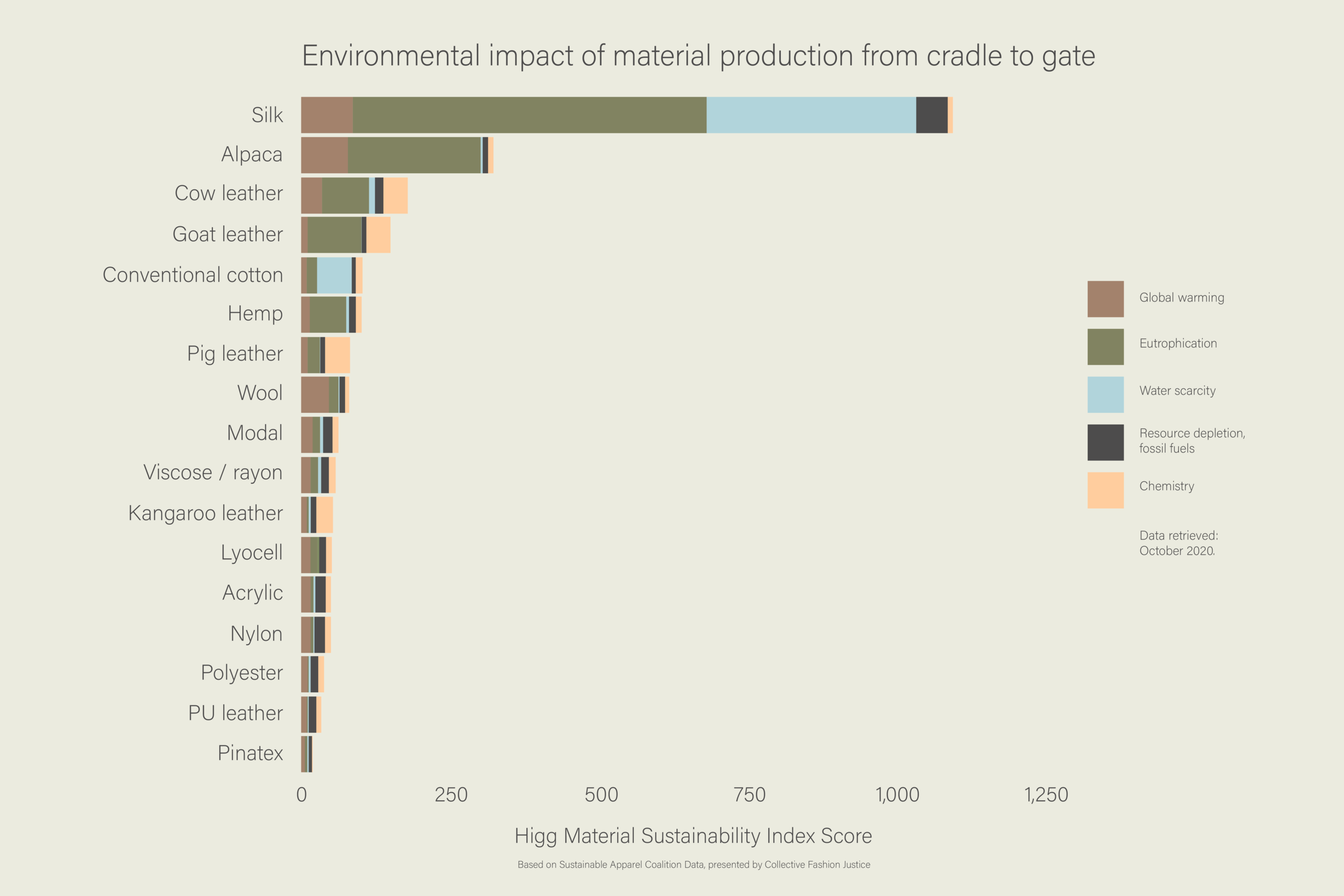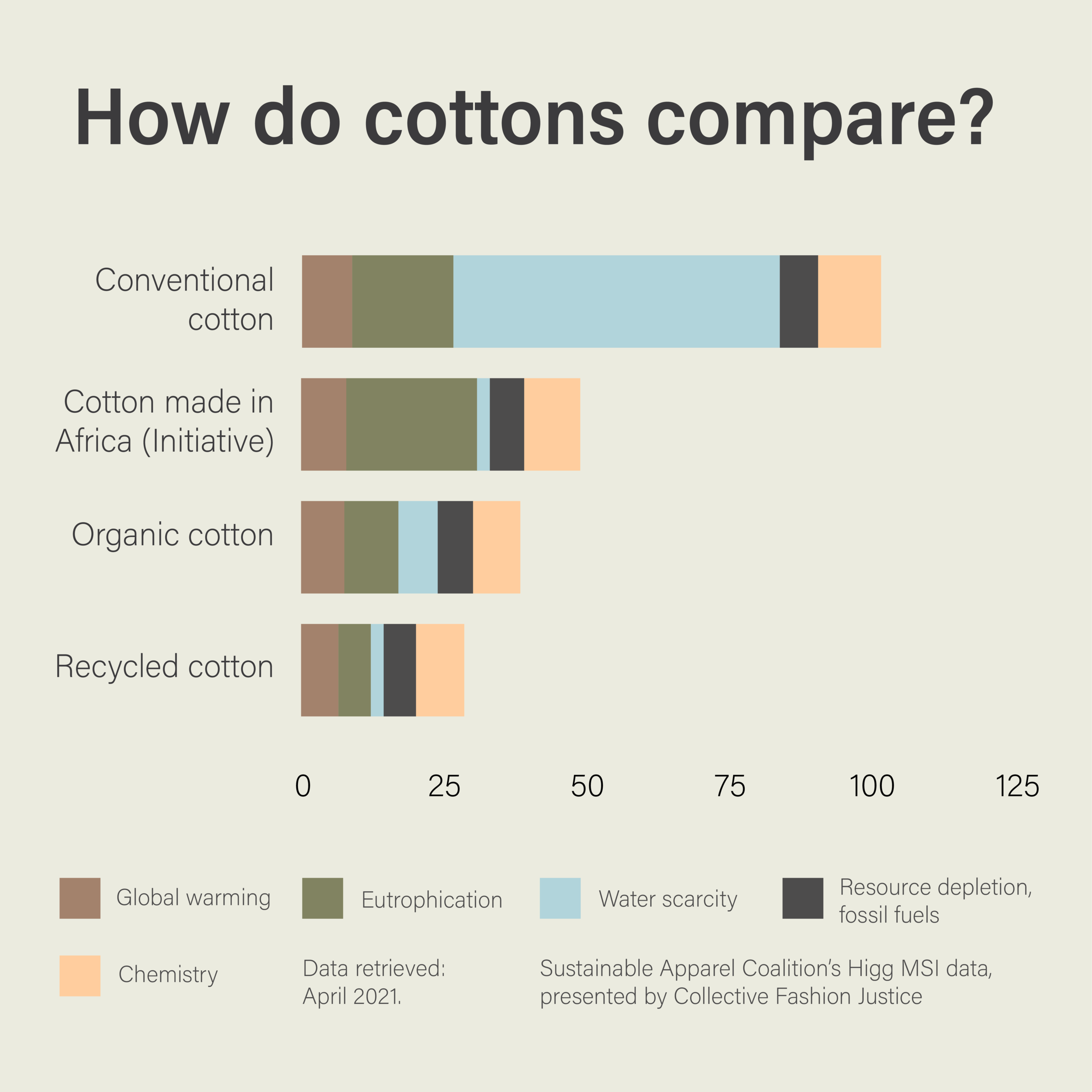Is cotton more sustainable than wool? It’s complicated.
When it comes to knitwear, cotton can be used as an alternative to both animal fibres like wool and cashmere, as well as synthetic fibres that harm oceans, like acrylic and nylon. As a plant, cotton is biodegradable, and as a fashion fibre, not borne of animal cruelty. But is it sustainable?
Why do we need an alternative to wool and other animal fibres?
Sheep and alpaca wool, as well as cashmere, are all produced from industries which commodify animals, and ultimately, slaughter them. It may come as a surprise, but these materials are far from cruelty-free, also often involving painful mutilations, and harmful, traumatic treatment. For a brief insight, these include the cutting off of sheep’s tails without any pain relief, and selective breeding and breeding practices which result in 15 million dead lambs each year in Australia alone.
In order to work towards a total ethics fashion system, one which values the wellbeing and safety of all — humans, non-humans and the planet — we need to move beyond using animals as materials. The production and use of animal-derived materials objectifies these individuals. When individuals are objectified, their mistreatment is justified, as their sentience, at least to some extent, is denied.
Why do we need an alternative to synthetic fibres?
If you’re seeking to avoid wool, synthetics aren’t the solution. These materials are tied up in the fossil fuel industry, as they are all different forms of plastic. These plastics also shed each time we wash synthetic garments, in microscopic fibres which enter waterways, and pollute the entire ecosystem, starting in the sea.
How do all of these materials compare, when it comes to environmental impact?
The current best available data on material production impact, is from the Sustainable Apparel Coalition’s Higg Material Sustainability Index. This index, for now, looks only at cradle to gate impact — meaning the impact involved in producing a material, but not the impact which comes from the afterlife of a material. For this reason, something like lack of biodegradability, or the shedding of microfibres, isn’t considered in the data set.
It’s critical for us to be aware of the environmental impact of producing materials (cradle to gate impact), because this is where a significant amount of harm to the planet occurs. So, here’s how different materials rank…
So sheep’s wool is more sustainable to produce than cotton?
While alpaca wool is the second most impactful material of all to produce, conventional wool is more sustainable than conventional cotton, when considering global warming impact, eutrophication, water scarcity, resource depletion and chemistry combined.
This is not to say that we should use sheep’s wool — there are myriad ethical reasons to steer clear of it — but to say that conventional cotton is not sustainable.
It is produced with significant amounts of water, it can result in eutrophication — a process which can result in dead-zones — when fertilisers and pesticides are used carelessly, and it can be harmful to biodiversity because of these pesticides.
Sheep’s wool (which is what this article will focus on) is not sustainable either — as large as conventional cotton’s water footprint is, wool has a massive carbon footprint — in fact alpaca and sheep’s wool are the second and third most climate impactful materials of all, with cotton coming in far behind. Did you know that producing the same knitted sweater, made of Australian wool as compared to Australian cotton, emits about 27 times more greenhouse gas emissions?
Are there more sustainable forms of cotton?
The Higg data set also calculates the impact of recycled cotton, organic cotton, and Cotton Made in Africa (this isn’t all cotton made in the continent, but a specific, certified form of African grown cotton). Here’s how these compare to conventional cotton:
As you can see, how cotton is grown, greatly changes its impact.
The greatest change across the above compared cottons is the water scarcity impact. Did you know that the global average water footprint for cotton varies greatly country by country? For example, cotton grown in the USA uses 61% less blue water (fresh, irrigation water). Australian cotton uses over 20% less than the global average, Brazilian less than 87% of the global average. On the flip side, Egyptian cotton uses 54% more than the global average, and Uzbekistan’s cotton crop on average uses 55% more blue water.
All of these materials — organic cotton, Cotton Made in Africa, recycled cotton, and likely cotton from some countries with reduced blue water usage, are less impactful to produce than wool. Of course, wool can be produced differently and in ways which can reduce impact too, but while water use can vary, sheep will always produce significant amounts of methane, leaving the fibre’s global warming impact harmfully intact.
There’s also more to consider than these five impacts.
The Higg Index only considers five impacts: global warming, water scarcity, eutrophication, abiotic resource depletion, and chemistry. Another very important impact to consider when agriculture is being discussed, is land use. For life to thrive on this planet, we need a biodiverse range of life — both plant and animal life. The more land that is cleared for unnatural human use — agriculture, housing and so on, the less biodiversity we will have.
More agricultural land is used for animal-derived fashion and food than anything else. Half of all habitable land – so forget glaciers and barren land – is used for agriculture. Of this land, 77% is used for raising animals for slaughter and growing crops to feed these animals. This is because animal-derived fibres and proteins are not land use efficient — you need a lot more land to produce a lot less, as compared to plant-based fibres. The same is true when we compare wool and cotton.
Australian wool is 367 times more land intensive than Australian cotton. This is a significant amount of land. Not only does this impact biodiversity, but it further impacts our climate. If we consider the carbon cost of land that is kept cleared, and thus not covered in natural flora that could act as a carbon sink, wool just bumped up its impact.
If we transitioned to an entirely plant-based agricultural system by 2050, we could sequester 99-163% of our carbon emission budget. This budget represents the total amount of carbon emissions we have left to release before any action is too late.
So which fibre is more sustainable?
Collective Fashion Justice supports the use of sustainably grown cotton. This includes organic cotton, recycled cotton (though it’s not so much grown), and Cotton Made in Africa. All of these materials are more sustainable than wool according to the Higg index.
We also support the use of some cotton outside of these, which have not been separately measured as a part of the Index. Such cotton we support is particularly more sustainable than the average, global conventional cotton crop. For example, Good Earth Cotton from Australia, and more broadly, sustainably sourced Australian cotton, which is continually improving — something we touch on in our short film, Willow and Claude.
Here comes some complexity.
We do not have a life cycle assessment comparison of every farm, whether growing wool or cotton, so the comparison of cotton fibre from one place, as compared to wool fibre from another, cannot be unequivocally answered to an exact number. Averages are important and useful tools for assessment, though.
Here’s what else we know. Cotton’s impact can vary greatly — largely by changing water usage and pesticide spraying practices. For example, we’ve seen Australian cotton water efficiency improve by about 48%, and pesticide usage decrease by about 97%, in about two decades.
Wool’s impact can vary too — for example fine merino wool has a carbon equivalent footprint of 30.6kg of CO2e per kilogram of wool., whereas wool from ‘prime lamb’ meat production systems has a carbon equivalent impact of 8.9kg of CO2e per kilogram.
This does complicate things, but it also doesn’t. Sheep’s wool is still a hugely inefficient, land and resource wasting fibre that contributes significantly to the climate crisis. If the Higg data included impacts tied to land clearing and associated carbon cost — not to mention biodiversity loss — the answer to the question of which fibre is more sustainable would likely be very clear, even when discussing conventional cotton.
What’s more, wool is all of these things, while also inherently unethical. And if there’s one thing that we cannot afford to sustain in our society, it is injustice and oppression. Yes, this article may be about sustainability, but no impact exists in a vacuum.
Don’t forget, there’s more to this discussion than ‘sustainability’.
Just as organic cotton is only a good choice if it’s also certified to be from farms and supply chains where farmers and workers are paid and treated fairly, the impact of wool cannot be separated from the harm this industry does to animals.
A perfect example of this, is the recognition that wool from lambs who are less than a year old before they are slaughtered, has a lowered carbon footprint. Does this really make for a ‘better fibre’?
Collective Fashion Justice will always preference cotton over wool, because wool is inherently tied to oppression, whereas cotton can be produced in a a total ethics supply chain. We will continue to advocate for cotton to improve, and for people to choose their cotton mindfully, based on transparent and solid information. At the same time, we will continue to assist in the just transition away from wool.




